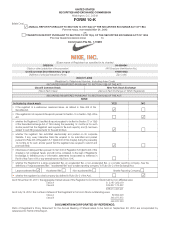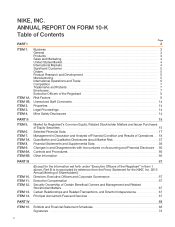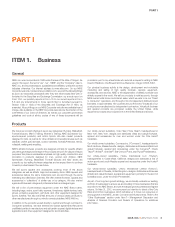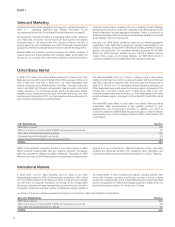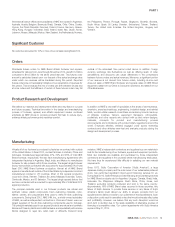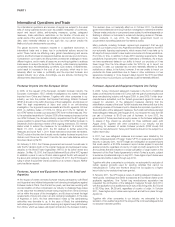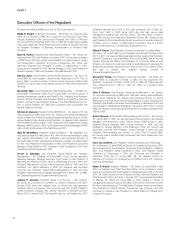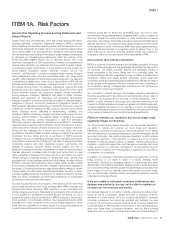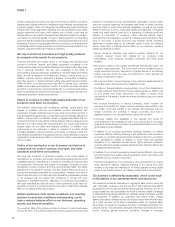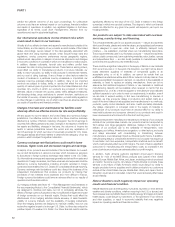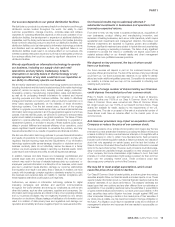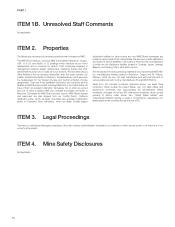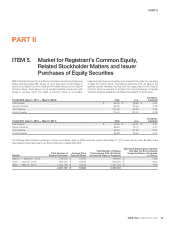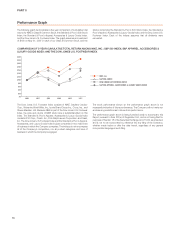Nike 2012 Annual Report Download - page 6
Download and view the complete annual report
Please find page 6 of the 2012 Nike annual report below. You can navigate through the pages in the report by either clicking on the pages listed below, or by using the keyword search tool below to find specific information within the annual report.
PART I
International Operations and Trade
Our international operations and sources of supply are subject to the usual
risks of doing business abroad, such as possible revaluation of currencies,
export and import duties, anti-dumping measures, quotas, safeguard
measures, trade restrictions, restrictions on the transfer of funds and, in
certain parts of the world, political instability and terrorism. We have not, to
date, been materially affected by any such risk, but cannot predict the
likelihood of such developments occurring.
The global economic recession resulted in a significant slow-down in
international trade and a sharp rise in protectionist actions around the
world. These trends are affecting many global manufacturing and service
sectors, and the footwear and apparel industries, as a whole, are not immune.
Companies in our industry are facing trade protectionist challenges in many
different regions, and in nearly all cases we are working together to address
trade issues to reduce the impact to the industry, while observing applicable
competition laws. Notwithstanding our efforts, such actions, if implemented,
could result in increases in the cost of our products, which may in turn
adversely affect our sales or profitability and the imported footwear and
apparel industry as a whole. Accordingly, we are actively monitoring the
developments described below.
Footwear Imports into the European Union
In 2005, at the request of the European domestic footwear industry, the
European Commission (“EC”) initiated investigations into leather footwear
imported from China and Vietnam. Together with other companies in our
industry, we took the position that Special Technology Athletic Footwear
(STAF) (i) should not be within the scope of the investigation, and (ii) does not
meet the legal requirements of injury and price in an anti-dumping
investigation. Our arguments were successful and the EU agreed in October
2006 on definitive duties of 16.5% for China and 10% for Vietnam for
non-STAF leather footwear, but excluded STAF from the final measures. Prior
to the scheduled expiration in October 2008 of the measures imposed on the
non-STAF footwear, the domestic industry requested and the EC agreed to
review a petition to extend these restrictions on non-STAF leather footwear. In
December 2009, following a review of the ongoing restrictions, EU member
states voted to extend the measures for an additional 15 months, until
March 31, 2011. In early 2011, the EC declined to further extend the
measures and since April 1, 2011 these restrictions have been terminated.
The EC noted at the time that it would monitor leather footwear imports from
Vietnam and China over the next 12 months. No new trade defense actions
have been taken by the EC.
On February 3, 2010, the Chinese government announced it would seek to
refer the EU decision (both on the original measures and subsequent review
decision) to the World Trade Organization (“WTO”) for its further review and
decision. On May 18, 2010, the Dispute Settlement Body of the WTO agreed
to establish a panel to rule on China’s claims against the EU with respect to
the above anti-dumping measures. On October 28, 2011, the WTO issued a
ruling in which it supported China’s positions on a number of issues. Neither
party has filed an appeal.
Footwear, Apparel and Equipment Imports into Brazil and
Argentina
At the request of certain domestic footwear industry participants, both Brazil
and Argentina have initiated independent anti-dumping investigations against
footwear made in China. Over the last two years, we have been working with
a broad coalition of other companies in our industry to challenge these cases
on the basis that the athletic footwear being imported from China (i) should
not be within the scope of the investigation, and (ii) does not meet the legal
requirements of injury and price in an anti-dumping investigation. In the case
of Argentina, in 2010, the final determination made by the administering
authorities was favorable to us. In the case of Brazil, the administering
authorities agreed to impose an anti-dumping duty against nearly all footwear
from China, which we believe will impact all brands in the footwear industry.
This decision does not materially affect us. In October 2011, the Brazilian
government initiated an anti-circumvention investigation to determine whether
Chinese-made products or components were subject to minimal assembly or
finishing in Vietnam or Indonesia to evade anti-dumping duties on Chinese-
made products. In July 2012, the Brazilian government found no
circumvention was taking place and this matter is closed.
Many products, including footwear, apparel and equipment, that we and
others in our industry import into Argentina and Brazil are subject to the WTO
non-automatic licensing requirements, which means that it may take up to
60 days for those products to clear customs and enter into those jurisdictions.
From time to time, in addition to these WTO licensing requirements, these
jurisdictions impose further importation restrictions or limitations. As a result,
we have experienced delays in our ability to import our products or it has
taken longer than the time allowed under the WTO for us to import our
products. To date, our business has not been materially affected by these
restrictions or delays. In the future, however, if we are unable to import our
products into these jurisdictions due to these or other restrictions or if we
experience increasing or more frequent delays beyond the WTO-permitted
60 days to import our products, our business could be materially affected.
Footwear, Apparel and Equipment Imports into Turkey
In 2006, Turkey introduced safeguard measures in the form of additional
duties on all imported footwear into Turkey with the goal of protecting its local
shoe manufacturing industry until August 2009. In June 2009, Turkish shoe-
manufacturers submitted, and the Turkish government agreed to review, a
request for extension of the safeguard measures claiming that the
rehabilitation process of the local Turkish industry was interrupted due to the
continuing increase of footwear imports. Despite the importers opposition to
the continuation of the safeguard measures, the Turkish authorities extended
these safeguard measures until August 2012, but reduced the duty from $3
per pair of footwear to $1.60 per pair of footwear. In June 2012, the
government of Turkey launched an expiry review on the footwear safeguards
to assess if they should be extended for three additional years (until
August 2015). Together with other companies in our industry, we are
advocating for exclusion of certain footwear products (STAF shoes) that
cannot be manufactured in Turkey and therefore should not be subject to a
higher import duty.
In 2011, two new safeguard measures and reviews were initiated by the
Turkish Undersecretariat of Foreign Trade (“UFT”) on apparel and equipment
imports. In January 2011, the UFT began an investigation on apparel imports
that could result in a 20-30% increase in import duties applied to imported
apparel products, regardless of country of origin and with exceptions for EU
and countries that are included in a cross-cumulation of origin system in the
framework of the Free Trade Agreements to which Turkey is a party, subject
to evidence of preferential origin. In July 2011, these higher import duties were
approved and will be in place through July 2014.
Together with other companies in our industry, we advocated for exclusion of
certain apparel products used for sporting activities that cannot be
manufactured in Turkey and therefore should not be subject to a higher
import duty but no exclusion has been granted.
In February 2011, the UFT began a review of existing safeguard measure on
travel goods, handbags and similar accessories and containers listed under
applicable regulations. One Turkish bag manufacturers association has
requested the continuation of the safeguard measures through April 2014,
with the application of an additional import duty of $2.50/kg (max. $3.75/unit)
to $2.70/kg (max. $4.25/unit), regardless of country of origin. In October
2011, these higher import duties were approved and will be in place through
April 2014.
Together with other companies in our industry, we advocated for the
exclusion of non-leather bags from the scope of the continued safeguards but
no exclusion has been granted.
6

